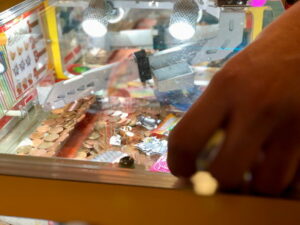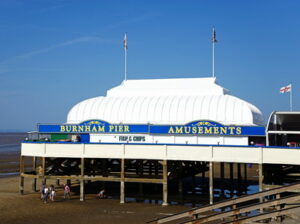 Not many people associate arcade games with gambling in the same way that they do with sports betting or casino games. However, they are regulated by the United Kingdom Gambling Commission (UKGC) just like casinos and bookmakers are.
Not many people associate arcade games with gambling in the same way that they do with sports betting or casino games. However, they are regulated by the United Kingdom Gambling Commission (UKGC) just like casinos and bookmakers are.
This means that arcade games certainly are a form of gambling, but how are they defined by the Commission? And have these types of games managed to become as popular as those aforementioned casino-type games?
Plus, what are the most popular arcade games, and furthermore, are they rigged? Have they been set up so that the house always wins in the end?
We’re going to be taking a closer look at these games and finding out exactly how they operate. And if they aren’t regulated in exactly the same way as casino games, how are they regulated?
Types of Amusement Arcade
 When the regulations for arcade gaming were being drafted, it seems as though law-makers weren’t able to find a way to regulate them all as one.
When the regulations for arcade gaming were being drafted, it seems as though law-makers weren’t able to find a way to regulate them all as one.
The issue may have been that arcade type games could be found in all manor of different types of establishment, from family holiday camps to pubs and casinos. In order to regulate effectively and still allow these venues the opportunity to offer arcade games as an attraction, three different types of amusement arcade were created.
These haven’t changed, and are as follows:
- Adult Gaming Centres (AGCs)
- Licensed Family Entertainment Centres (FECs)
- Unlicensed Family Entertainment Centres (UFECs)
Premises offering different types of amusements require different types of licences, and the type and number of arcade games they have is restricted by their license.
The unlicensed FECs, for example, can only offer category D machines in their establishments, and this can only be done if they obtain the necessary gaming machine permit from their local licensing authority. These are the lowest tier of games, and as such their number is not restricted provided a permit has been acquired.
Of course, when it comes to the AGCs, nobody under the age of 18 can enter these premises. Confusingly, these can sometimes be found within licensed FECs, although they must be gated and the same age restrictions apply to them. Even if you’re visiting an FEC with your children, they cannot enter the AGC area of establishment with you.
Age restrictions do not apply when it comes to the unlicensed FECs noted earlier.
The types of games that each of these arcade establishments can provide are as follows:
| Type of Arcade | Categories of Machines Permitted |
|---|---|
| AGC | B3, B4, C and D |
| FEC | C and D |
| UFEC | D |
Machine Categories for Arcade Establishments
| Maximum Stake | Maximum Prize | |
|---|---|---|
| D Money Prize | 10p | £5 |
| D Non-Money Prize (Other Than Crane Grab Machine) | 30p | £8 |
| D Non-Money Prize (Crane Grab Machine) | £1 | £50 |
| D Combined Money and Non-Money Prize (Other Than Coin Pusher or Penny Falls Machines) | 10p | £8 (of which no more than £5 may be a money prize) |
| D Combined Money and Non-Money Prize (Coin Pusher or Penny Falls Machines) | 20p | £20 (of which no more than £10 may be a money prize) |
The categories noted above for the different arcade establishments dictate what types of gaming machines are allowed on the premises. All of them can feature category D games, and while these are permitted in casinos, bingo halls, members’ clubs, and betting shops, it’s uncommon to find them in such.
Instead, they usually show up in AGCs, FECs, pubs, and travelling fairs. Five different combinations of stake and prize for the category D games are available, as shown in the table above.
 When you look at the descriptions of category D arcade games, it’s easy to understand what the UKGC is referring to. In fact, the crane grabbers, penny falls machines and coin pushers are some of the most prolific and popular games to play in arcade establishments.
When you look at the descriptions of category D arcade games, it’s easy to understand what the UKGC is referring to. In fact, the crane grabbers, penny falls machines and coin pushers are some of the most prolific and popular games to play in arcade establishments.
That being said, there have been several instances where coin pusher and grabber machines have been labelled as both rigged and addictive. While other people have suggested that there are certain ways to beat the machines and ensure that you win, but this isn’t true at all.
Many of these arcade games have been set up so that the vast majority of people don’t come away with anything except a hole in their pocket where money once was. Although a lot now spit out tickets which you can trade for ‘prizes’. In fact, research shows that the only real difference between pub favourites such as fruit machines and arcade games that appeal more to children, is the external appearance. Everything inside operates in pretty much the same way.
The games mentioned above are not down to skill, but pay out based on a pre-determined percentage chance set by the operators themselves. A more recent crackdown on the gambling industry overall means that the arcade games spoken of are regulated by the British Amusement Catering Trade Association (BACTA) now. It is because of this organisation that players are made aware of what category of game they’re playing, so a small square on the front of them with the wording “Cat D” should be seen.
Category C
 An FEC is able to incorporate category C games into its establishment alongside the category D amusements. There aren’t different types of games within this category, they are all slots, but different venue types are allowed to have different numbers of Cat C machines.
An FEC is able to incorporate category C games into its establishment alongside the category D amusements. There aren’t different types of games within this category, they are all slots, but different venue types are allowed to have different numbers of Cat C machines.
Category C type games are permitted in casinos set up under both the 1968 and 2005 Gambling Acts, in betting shops, tracks with pool betting, bingo premises, AGCs, members’ clubs, miners’ welfare clubs or commercial clubs, licensed FECs, and pubs.
The maximum number of machines from this category that each location can offer is as follows:
| Premises | Maximum Machines |
|---|---|
| Pubs | 2 (or specified amount with a permit granted by local authority) |
| Members’, Miners’ and Commercial Clubs | 3 |
| Bingo Premises, AGCs and FECs | Unlimited |
| Betting Shops and Tracks with Pool Betting | 4 made up of any combination of games from categories B through to D |
| 2005 Act Large and Small Casinos | 150 for large casinos and 80 for small made up of any combination of games from categories B through to D |
| 1968 Act Casinos | 20 made up of any combination of games from categories B through to D or any number of C or D machines instead |
Pubs and other establishments with alcohol licences are automatically entitled to have two category C or D gaming machines upon notification to the local licensing authority.
The maximum stake that can be placed on these games is £1, and the maximum win for anyone has to be set at £100.
Category B3 & B4

For the AGCs, C and D category games can be included, but the B3 and B4 options will most likely be dominant.
What exactly are these? Well, the B3 games can have maximum stakes of £2 and a maximum prize of £500. B4 category games also have a maximum stake of £2 attributed to them but can only pay out a maximum of £400.
In terms of arcades, only AGCs are able to incorporate these machine types. However, you can also find them in operation within betting shops, casinos, tracks with pool betting, bingo premises and the various clubs.
An AGC that holds a licence granted prior to July 13th 2011 is entitled to make four category B3 and B4 machines available on their premises. Speaking of the licence, what exactly is this in reference to AGCs and the others? Well, let’s take a look.
AGC, FEC and UFEC Licences
 Because these games are classed as gambling, establishments incorporating them require specific licences.
Because these games are classed as gambling, establishments incorporating them require specific licences.
The licence for an AGC is different to the one required for an FEC, and obviously, an unlicensed centre doesn’t need a license at all. UFEC premises simply need to acquire a council permit to offer their category D games.
The fee that needs to be paid for an AGC licence depends upon the expected annual gross gambling yield (GGY). So what they earn, in other words. Anything from below £200,000 and up to £7.5 million in GGY will cost £879 annually for a license. After this, the increments go up to £1,464, £4,394 and onwards.
The highest application fee is £14,647 for those premises doing GGY of between £30 million and beyond. Any sort of combination licence will also allow operators to pay a discounted licence fee. Those prices are exactly the same for UK FECs as well, although these premises aren’t realistically going to be bringing in more than £125 million in GGY.
Biggest Instances of Reported Arcade Game Fixing
 It’s not uncommon for people to genuinely believe that arcade games are heavily rigged. Of course, they are weighted in the venue’s favour, but they are not ‘rigged’ in the sense of anything dishonest.
It’s not uncommon for people to genuinely believe that arcade games are heavily rigged. Of course, they are weighted in the venue’s favour, but they are not ‘rigged’ in the sense of anything dishonest.
One of the most commonly accused arcade games is the grabbing crane machines. We’ve all had those instances of the claw grabbing an item, hoisting it up, and then unceremoniously dropping it again before it reaches the exit.
In July of 2019, a woman named Cheryl Holden reported visiting a Parkdean Resort and paying to use a grabber machine. She proceeded to spend a total of £100 on the game, trying to win soft toys by guiding the claw to grab one and deposit it. However, after losing so much, she claimed that the machines had all been rigged to stop people from winning.
Cheryl had been trying to win a soft toy for her five-month-old son, Ashton. She put £40 into the machine, with four attempts costing £1.
After the £40 had gone, Cheryl complained to a staff member that she had spent so much and hadn’t won anything. The staff member thrn supposedly opened the machine up, changed a setting, and Cheryl won on the following round. According to Cheryl though, the machine was then opened again and reset.
She spent another £60 over the next few days without winning, and this was when she decided to make a complaint. This time, she called the manager of Parkdean, who apparently laughed off the complaining mum, hinting that making a complaint wouldn’t get her anywhere.
There was an internal investigation but no evidence of cheating was ever found.
Cyclone Game in the USA
An instance where an arcade game was actually discovered to be rigged came in 2018.
A YouTuber named Mark Rober built his own device to effectively cheat at playing the Cyclone game, which is supposed to test your reaction skills. A light travels quickly around the machine and you have to hit your button when it gets to your spot. That’s quite tough for a human, but Mark Rober constructed a machine that could precisely trigger the button press to within a millisecond. It should have been able to win every single time.
However, when Rober attached it to a Cyclone game, the game ended up ‘cheating’. It would report Rober had missed by a tiny margin, sometimes being too quick on the draw and other times too slow, yet Rober knew from his own tests that his machine was 100% accurate.
The game paid out every 30 rounds or so, and Rober wasn’t changing any settings, so he figured something was fishy. It wasn’t until he got his hands on an operational manual that he could prove it though. The game can be set by the operator to pay out on different frequency settings.
So it wasn’t ‘rigged’ as such, it did pay out, but the result you got was nothing to do with your reaction times, and all to do with pure luck.
I should point out that this was in the USA where regulations are different – this wouldn’t be allowed to happen in the UK.
Companies Try to Bring People Back
 A decline in the popularity of arcade games, not necessarily only due to accusations of rigging, was experienced by arcades several years ago. This led to a major industry trade group in the US taking action to try and win players’ trust back following a huge lawsuit against a high-profile games manufacturer.
A decline in the popularity of arcade games, not necessarily only due to accusations of rigging, was experienced by arcades several years ago. This led to a major industry trade group in the US taking action to try and win players’ trust back following a huge lawsuit against a high-profile games manufacturer.
The US-based group set about forcing its members such as Sega and Bandai Namco, to sign a “fair play pledge”, which would proceed with promising that all games met with a standard level of performance to give players a fair chance of winning. A spokesman for the American Amusement Machine Association (AAMA) said that they wanted to put emphasis on the fact that they aren’t “in the business of rigging games”.
The signing of the pledge would relate to the construction of redemption machines, such as ticket-and-claw, penny fall and ball throwing games. Back in 2016, a huge report was made on how operators of the arcade claw machines can adjust the strength of the claw itself so as to affect the outcome of gameplay. Only three years prior to that, a court case had alleged that the Sega Keymaster game was also rigged, being labelled as “false, deceptive and likely to mislead consumers”.
Sega agreed to a settlement of $650,000 in that particular case, but it was thrown out by a judge in the end, stating it would be too difficult to reimburse anyone who had played that particular game.
The Vice President of AAMA, Pete Gustafson stated that all games released in future would be very much winnable by players who have a skillset capable of doing so. This, he said, would not make the games easier, but there will be no rigging involved in their manufacture and operation.